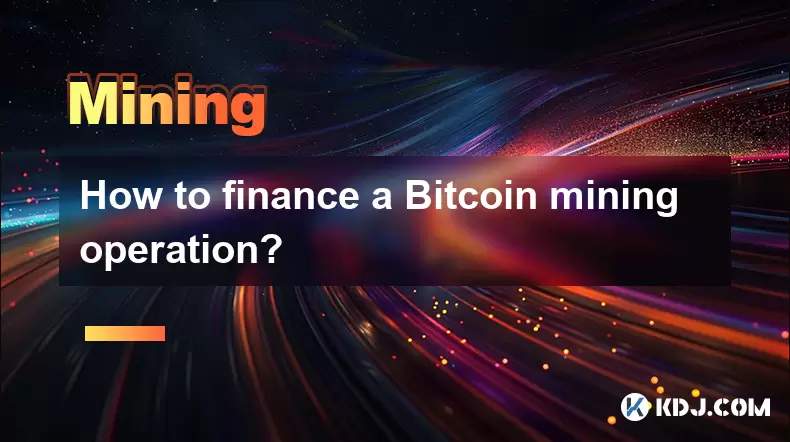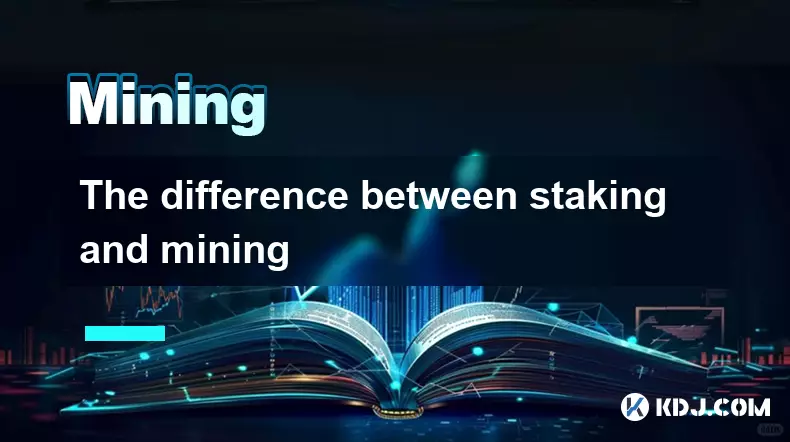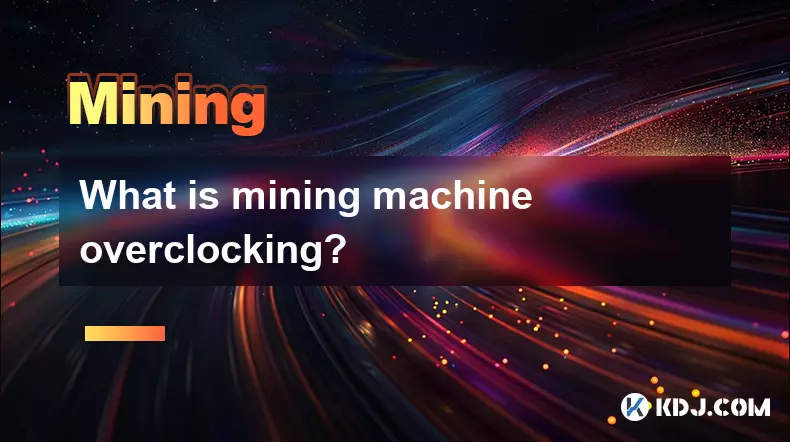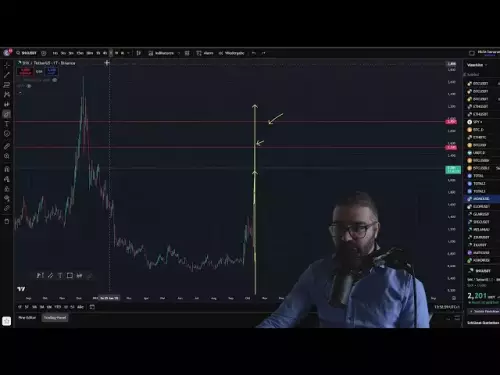-
 bitcoin
bitcoin $115692.075601 USD
5.13% -
 ethereum
ethereum $4162.931611 USD
11.68% -
 bnb
bnb $1310.063287 USD
17.56% -
 tether
tether $1.000983 USD
0.00% -
 xrp
xrp $2.534505 USD
8.16% -
 solana
solana $198.235737 USD
13.49% -
 usd-coin
usd-coin $1.000236 USD
0.02% -
 dogecoin
dogecoin $0.207352 USD
12.89% -
 tron
tron $0.323043 USD
3.62% -
 cardano
cardano $0.701559 USD
11.88% -
 hyperliquid
hyperliquid $39.924597 USD
8.30% -
 chainlink
chainlink $18.934457 USD
11.56% -
 ethena-usde
ethena-usde $1.000552 USD
0.02% -
 stellar
stellar $0.340575 USD
7.05% -
 bitcoin-cash
bitcoin-cash $545.011757 USD
8.86%
How to finance a Bitcoin mining operation?
Bitcoin mining requires significant investment in specialized hardware and cheap electricity to remain profitable amid fluctuating crypto prices and rising operational costs.
Jul 19, 2025 at 02:43 pm

Understanding Bitcoin Mining and Its Financial Requirements
Bitcoin mining is the process of validating transactions on the blockchain network by solving complex cryptographic puzzles. To finance a Bitcoin mining operation, you must first understand the financial commitments involved, which include hardware costs, electricity consumption, cooling systems, maintenance, and potentially cloud mining fees. Each of these factors plays a critical role in determining whether your mining venture will be profitable or not.
The core of any mining setup is the mining hardware, such as ASIC (Application-Specific Integrated Circuit) miners. These devices vary significantly in cost, with high-end models like the Bitmain Antminer S19 Pro or MicroBT WhatsMiner M30S commanding prices upwards of $2,000 to $5,000 per unit. The number of machines you acquire directly affects your initial investment and potential hash rate output.
Selecting the Right Mining Hardware
Choosing the appropriate mining equipment is essential for optimizing profitability. Key metrics to consider include:
- Hash rate: Measured in terahashes per second (TH/s), this indicates how quickly a miner can solve cryptographic puzzles.
- Power efficiency: Expressed in joules per terahash (J/TH), more efficient miners consume less electricity for the same output.
- Cost-to-performance ratio: Evaluate how much you're paying relative to the miner’s expected output and energy usage.
For instance, a miner offering 110 TH/s with a power draw of 3250W might be more suitable than one providing 80 TH/s at 3400W if it fits within your budget. Always compare multiple models before making a purchase decision.
Securing a Reliable Power Source
Electricity costs are arguably the most significant ongoing expense in Bitcoin mining. Therefore, identifying a location with cheap and stable electricity is crucial. Some miners set up operations in regions known for low-cost hydroelectric or geothermal power, such as parts of Canada, Iceland, or certain states in the U.S. like Washington.
Before finalizing a site, calculate the cost per kilowatt-hour (kWh) and estimate monthly expenses based on the total wattage of your mining rigs. For example, if you operate ten miners each drawing 3,000W continuously and your local utility charges $0.06 per kWh, your monthly bill would be approximately:
- Total power: 10 * 3,000W = 30,000W = 30kW
- Daily consumption: 30kW * 24 hours = 720kWh
- Monthly consumption: 720kWh * 30 days = 21,600kWh
- Cost: 21,600kWh * $0.06 = $1,296/month
This calculation helps determine whether your revenue from mined Bitcoin will cover operational costs.
Funding Options for Your Mining Operation
To finance a Bitcoin mining operation, several funding avenues are available:
- Personal savings: Using your own capital allows full control over the operation without debt obligations.
- Loans: Traditional bank loans or cryptocurrency-backed financing platforms can provide necessary funds, though interest rates and repayment terms should be carefully considered.
- Crowdfunding or partnerships: Pooling resources with other investors can reduce individual risk while increasing mining capacity.
- Cloud mining contracts: Instead of purchasing physical hardware, some opt to rent hashing power from cloud mining providers. This method eliminates upfront hardware costs but introduces counterparty risks.
Each option comes with trade-offs. For instance, taking out a loan increases leverage but also financial exposure if mining becomes unprofitable due to fluctuating Bitcoin prices or rising energy costs.
Setting Up the Mining Infrastructure
After securing funding and hardware, setting up the actual mining infrastructure involves several steps:
- Cooling system installation: High-performance miners generate substantial heat. Proper ventilation, fans, or even industrial air conditioning units may be required to prevent overheating.
- Network connectivity: Ensure a stable internet connection with minimal latency. Ethernet connections are preferred over Wi-Fi for reliability.
- Mining software configuration: Install and configure mining software like CGMiner, BFGMiner, or manufacturer-specific tools. These programs connect your hardware to mining pools and manage hashing activity.
- Joining a mining pool: Solo mining is rarely profitable unless you have a large-scale operation. Joining a mining pool like F2Pool, Slush Pool, or AntPool allows you to combine hash power with others and receive regular payouts.
Proper infrastructure ensures continuous operation and reduces downtime, which is vital for maintaining profitability.
Monitoring and Optimizing Mining Performance
Once your operation is running, constant monitoring and optimization are necessary to ensure efficiency:
- Use dashboards provided by mining software or third-party tools to track real-time performance metrics like hash rate, temperature, and accepted shares.
- Regularly clean hardware to prevent dust buildup that can cause overheating.
- Adjust mining pool settings or switch pools if payout structures become unfavorable.
- Recalculate profitability periodically based on Bitcoin price fluctuations and electricity costs.
Optimizing your setup not only improves output but also extends the lifespan of your mining hardware.
Frequently Asked Questions
Q: Can I start Bitcoin mining with a regular computer?A: While early Bitcoin mining was possible with CPUs and GPUs, modern mining requires specialized ASIC hardware. Attempting to mine with standard PCs is no longer profitable due to low hash rates and high power consumption.
Q: How long does it take to recoup the initial investment in mining hardware?A: The payback period varies depending on factors like Bitcoin price, mining difficulty, electricity costs, and hardware efficiency. It typically ranges from 6 months to over a year.
Q: Is Bitcoin mining legal everywhere?A: No, Bitcoin mining legality varies by country. Some nations like China have banned mining, while others like the U.S., Canada, and Germany allow it under certain regulations.
Q: What happens if Bitcoin's price drops significantly during mining?A: A drop in Bitcoin price can make mining unprofitable, especially if electricity costs remain high. Miners may need to pause operations temporarily or optimize their setups to reduce expenses.
Disclaimer:info@kdj.com
The information provided is not trading advice. kdj.com does not assume any responsibility for any investments made based on the information provided in this article. Cryptocurrencies are highly volatile and it is highly recommended that you invest with caution after thorough research!
If you believe that the content used on this website infringes your copyright, please contact us immediately (info@kdj.com) and we will delete it promptly.
- XRP Price Prediction: Weekend Rollercoaster or Rally?
- 2025-10-12 08:45:16
- Bittensor (TAO): Super Bullish Signals Point to Potential 2x Rally
- 2025-10-11 10:25:12
- Silver Price Correction: Navigating the Dip & Identifying Key SEO Keywords
- 2025-10-11 10:25:12
- Decoding Crypto Trends: Bittensor's Bull Run, Cardano's Dip, and LivLive's Presale Buzz in 'Uptober 2025'
- 2025-10-12 08:45:16
- MoonBull: The Crypto Meme Coin Promising 1000x Gains?
- 2025-10-11 10:30:01
- Crypto Payroll Revolution: Stablecoins, Altcoins, and the Future of Salary Payments
- 2025-10-11 10:30:01
Related knowledge

The difference between staking and mining
Sep 24,2025 at 05:18am
Understanding Staking in the Cryptocurrency Ecosystem1. Staking involves holding funds in a cryptocurrency wallet to support the operations of a block...

How to participate in testnet mining?
Sep 22,2025 at 09:18am
Understanding Testnet Mining in the Crypto Ecosystem1. Testnet mining is a method used by blockchain developers to simulate real-world conditions on a...

How to dispose of abandoned mining machines?
Sep 19,2025 at 08:19pm
Assessing the Condition of Abandoned Mining Rigs1. Begin by inspecting each mining machine for visible damage, corrosion, or missing components. Machi...

How to identify high-quality mining pools?
Sep 21,2025 at 03:19pm
Reputation and Track Record1. A mining pool’s reputation is built over time through consistent performance and transparency. Pools that have operated ...

Advantages of decentralized mining pools
Sep 20,2025 at 04:36pm
Enhanced Security and Resistance to Censorship1. Decentralized mining pools operate on blockchain-based smart contracts, eliminating the need for a ce...

What is mining machine overclocking?
Sep 21,2025 at 07:19pm
Understanding Mining Machine Overclocking1. Mining machine overclocking refers to the process of increasing the operating frequency of a cryptocurrenc...

The difference between staking and mining
Sep 24,2025 at 05:18am
Understanding Staking in the Cryptocurrency Ecosystem1. Staking involves holding funds in a cryptocurrency wallet to support the operations of a block...

How to participate in testnet mining?
Sep 22,2025 at 09:18am
Understanding Testnet Mining in the Crypto Ecosystem1. Testnet mining is a method used by blockchain developers to simulate real-world conditions on a...

How to dispose of abandoned mining machines?
Sep 19,2025 at 08:19pm
Assessing the Condition of Abandoned Mining Rigs1. Begin by inspecting each mining machine for visible damage, corrosion, or missing components. Machi...

How to identify high-quality mining pools?
Sep 21,2025 at 03:19pm
Reputation and Track Record1. A mining pool’s reputation is built over time through consistent performance and transparency. Pools that have operated ...

Advantages of decentralized mining pools
Sep 20,2025 at 04:36pm
Enhanced Security and Resistance to Censorship1. Decentralized mining pools operate on blockchain-based smart contracts, eliminating the need for a ce...

What is mining machine overclocking?
Sep 21,2025 at 07:19pm
Understanding Mining Machine Overclocking1. Mining machine overclocking refers to the process of increasing the operating frequency of a cryptocurrenc...
See all articles










































































